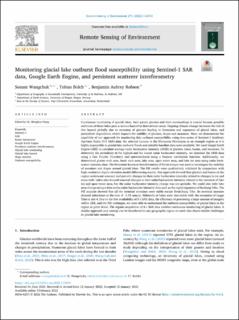| dc.description.abstract | Continuous monitoring of glacial lakes, their parent glaciers and their surroundings is crucial because possible outbursts of these lakes pose a serious hazard to downstream areas. Ongoing climate change increases the risk of this hazard globally due to recession of glaciers leading to formation and expansion of glacial lakes, and permafrost degradation which impacts the stability of glaciers, slopes and moraines. Here, we demonstrate the capability of our approach for monitoring lake outburst susceptibility using time-series of Sentinel-1 Synthetic Aperture Radar (S-1 SAR) data. We selected Lunana in the Bhutanese Himalayas as an example region as it is highly susceptible to glacial lake outburst floods and suitable baseline data were available. We used Google Earth Engine (GEE) to calculate average radar backscatter intensity (ARBI) of glaciers, lakes, basins, and moraines. To determine the periodicity of the highest and the lowest radar backscatter intensity, we denoised the ARBI data using a Fast Fourier Transform and autocorrelated using a Pearson correlation function. Additionally, we determined glacier melt area, basin melt area, lake area, open water area, and lake ice area using radar backscatter intensity data. The Persistent Scatterer Interferometry (PSI) technique was used to investigate the stability of moraines and slopes around glacial lakes. The PSI results were qualitatively validated by comparison with high-resolution digital elevation model differencing results. Our approach showed that glaciers and basins in the region underwent seasonal and periodic changes in their radar backscatter intensity related to changes in ice and snow melt. Lakes also showed seasonal changes in their radar backscatter intensity related to the variation of lake ice and open water area, but the radar backscatter intensity change was not periodic. We could also infer lake area change using a time-series radar backscatter intensity data such as the rapid expansion of Bechung Tsho. The PSI analysis showed that all the terminal moraines were stable except Drukchung Tsho. Its terminal moraine showed subsidence at the rate of –5.18 mm/yr. Sidewalls of lakes were also stable with the exception of Lugge Tsho at site 4. Due to the free availability of S-1 SAR data, the efficiency of processing a large amount of imagery within GEE, and the PSI technique, we were able to understand the outburst susceptibility of glacial lakes in the region at great detail. The regular acquisition of S-1 SAR data enables continuous monitoring of glacial lakes. A similar approach and concept can be transferred to any geographic region on earth that shares similar challenges in glacial lake monitoring. | en_US |

